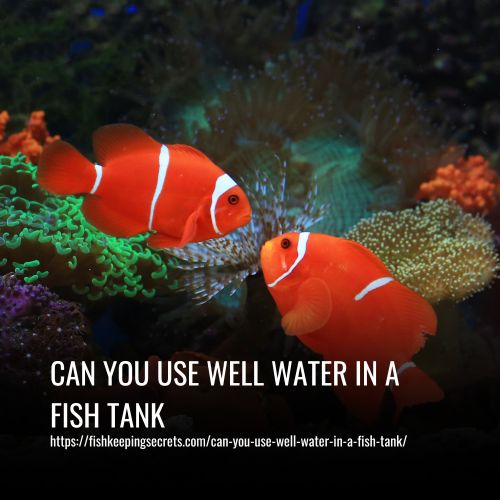Can You Use Well Water In A Fish Tank
This post contains affiliate links. As an Amazon Associate, we earn from qualifying purchases.
Using well water in a fish tank is possible, but it depends on the quality of the water. Well, water contains minerals that may affect the pH and hardness of the tank water.
It is recommended to test the well water for any harmful chemicals or contaminants before using it for fish tanks. Additionally, treating the well water with a dechlorinator may be necessary to remove any chlorine or chloramines present.

Is Well Water Safe For Fish Tanks?
It is possible to use well water in a fish tank, but it is important to test the water beforehand to make sure it is safe for your fish. The pH level should be checked as it needs to match the requirements of your fish. If the levels are not suited for your fish, you can condition the well water to meet these needs.
Additionally, you should also check the water for ammonia and nitrates, as well as heavy metals and salts which can be toxic for fish. Testing the water sample will help determine the concentrations of these substances in order to ensure that they do not exceed safety levels.
Therefore, if you plan on using well water in your fish tank, make sure to take necessary precautions and regularly monitor health readings.
Can Well Water Kill Fish?
Checking the water parameters of well water is necessary before introducing it to a fish tank. Well, water generally has more carbon dioxide and different levels of contaminants, including minerals, heavy metals, nitrates, and other toxins. These pollutants can be harmful to your fish if the pH level is beyond their tolerance limit or if there are too many nitrogen or mineral levels in the water.
The presence of these contaminants can poison your fish or even cause death. For the safety of your fish, it is essential to know what type of water you are adding and ensure that its pH level is appropriate for their needs while also keeping any pollutants below acceptable levels.
How To Use Well Water In Your Fish Tank?
When adding well water to your fish tank, it’s important to make sure the water is free of contaminants such as minerals, heavy metals, nitrates, and other pollutants. Additionally, because well water contains more carbon dioxide than surface water, it is essential to check the parameters of your well water before introducing it into the tank.
If your well water has high levels of these pollutants or its pH level is beyond the tolerance of your fish, it can harm them and may even lead to death. To ensure that your fish stay healthy and safe, test the quality of your well water before adding it to your aquarium.
Treatment Of Well Water
Chlorinated water can be dangerous for fish, but there are measures that can be taken to make it safe. First, letting the water sit for a day or two will help remove chlorine from the water, as well as cause sediments and natural contaminants to separate. You can also use an aerator to speed up this process.
Heavier metals and minerals can be removed from water by using a reverse osmosis filtration system to make it softer. However, using an RO filter will also remove trace elements necessary for your fish, so you must add them back in with a salt mix.
Properly filtering and treating your aquarium water before adding fish is essential for their health and safety.
Conditioning Of The Treated Water
Conditioning your aquarium water is essential for the health and well-being of your fish. It involves treating water to reduce contaminants and adjusting the pH level to match the needs of the particular species of fish in a tank. This can be done with various ingredients, such as limestone, coral, peat moss, driftwood, or a salt mix.
The pH level of an aquarium can be adjusted by adding limestone and coral to raise it, or peat moss and driftwood to lower it. Salt can be used to re-mineralize water and provide your fish with the nutrients they need for optimal health. Once you’ve adjusted and treated the water to fit the requirements of your fish, you can add it to your aquarium for them to enjoy!
Can You Use Well Water In A Saltwater Fish Tank?
If you’re thinking of using well water in a saltwater fish tank, there are some important safety precautions that you must take. Well, water may contain heavy metals, nitrates, phosphates, and other salts that could harm your fish. To eliminate these toxins and minerals from the water, it must first be properly conditioned.
This can involve using a resin filter to remove any impurities and adding a suitable salt mix to adjust the pH level and salinity. Additionally, you will have to keep an eye on the Total Dissolved Solids (TDS) level to make sure it is low.
The Advantages of Using Well Water In Your Aquarium
Well, water is a great source of natural water for an aquarium, as it has already been filtered by the soil on its way down. It can give an advantage over municipal water supplies as it does not contain chlorine, chloramine, fluoride, and other chemicals that can potentially be dangerous to your fish and their environment.
However, it is important to assess whether the composition of your well water matches the needs of your fish before you use it in your aquarium – if not, then you may need to purify it before adding it to the tank.
Potential Problems With Using Well Water In Aquariums
It is important to consider several factors before adding water from your well to your aquarium. Depending on where your well is located, it may contain contaminants such as heavy metals, nitrates, and bacteria that can be harmful to fish. Additionally, some people treat their well water with chlorine compounds which can be deadly to fish and beneficial bacteria in the tank.
The pH of the water is also crucial for the health of your fish. Fish from different regions have varied pH requirements: Amazonian fish prefer acidic-neutral water at a pH of 6.5-7.0, whereas African Cichlids need more alkaline conditions with a pH of 7.4-9.3. The acidity or alkalinity of the water from your well will depend on the local geology: Soils containing limestone or dolomite will yield water that tends to be more alkaline, whereas soils containing peat tend to be more acidic.
Therefore, it is important to test the pH level of your well’s water before adding it to your tank, as getting this wrong could lead to harm or death for some species of fish!
Water quality is an extremely important factor for fish health, and there are some key aspects that you need to consider. Water hardness refers to the measure of dissolved minerals in the water, and ideally should be between 10-15 dGH depending on the species of fish.
Additionally, providing oxygen-rich water can help ensure your fish have sufficient oxygen levels to thrive. You can provide aeration or add surface agitation to increase oxygen levels if needed. It is also important to maintain good water circulation and filtration, as well as provide regular partial water changes to keep the tank clean.
How To Make Your Well Water Safe For Your Aquarium Fish
Making your well water safe for your aquarium fish is a process that requires careful preparation and monitoring.
1. Test Your Well Water:
It is important to test your water if you keep fish in an aquarium. A suitable testing kit for this purpose should include tests for pH, ammonia, nitrite, nitrate, chlorine, hardness, and lead. The API Freshwater Master Test Kit is an example of a convenient all-in-one package that contains these tests.
The Safe Home Well Water Test Kit is an excellent option for this purpose since it tests for 14 different parameters. This kit includes 242 total tests and comes with bonus benefits such as promo codes and access to the E-Learning Center & Water Treatment Options. By using these testing kits regularly, you can ensure that your fish live in a safe and healthy environment.
2. Filter Your Well Water:
Using well water for your fish tank can be a great idea if the water has been tested and is free of any harmful contaminants. Water containing high concentrations of minerals, such as iron, manganese, or chlorine, should be subjected to filtration.
There are several filtration options available at a low cost to effectively reduce these elements. The Waterdrop Whole House Water Filter System is one example that will remove large particles and sediments as well as more than 95% of iron, manganese, and chlorine content.
This system also has a longer lifespan which helps to save on replacement costs over time. It is important to ensure that the filter system can handle normal work pressure of 25-90psi without damaging the structure before purchasing. By investing in a good water filtration system, you can ensure the safety and health of your fish while using well water in your aquarium.
Alter the pH and Hardness of Your Well Water
Altering the pH and hardness of your well water is an important step to ensure that it is suitable for your aquarium fish.
1. Make Your Well Water More Alkaline:
It is possible to adjust the pH of aquarium water by adding alkalizing agents or substances. Baking soda can be used when filling the tank or making a partial water change, with one teaspoon required per 5-10 gallons of water depending on the desired degree of pH change.
Substrates and rocks such as dolomite gravel and limestone rocks can also be used to help keep your tank’s pH at a higher level for longer periods. However, it is important to add them in the right quantity and test your water regularly to ensure that they are having the desired effect.
2. Make Your Well Water More Acidic:
Maintaining good water quality is essential for the health of your fish. If the pH of your tank is too high, there are several ways to naturally lower it. You can filter the water through peat or add Indian almond leaves or pieces of hardwood to your tank, as these materials contain tannins that make the water more acidic.
Seachem Purigen can help reduce the color of water while preserving acidity. Alternatively, some aquarists have tried adding white vinegar to their water to lower the pH at a rate of around half a teaspoon for every 10 gallons – though you should test and make sure not to add too much vinegar as it may become toxic for your fish!
Well Water is Great for Aquariums
Having well water can be a great benefit to those with home aquariums. Since well water is naturally drawn from the earth’s aquifer, it contains no chlorine or other additives that could cause harm to your fish.
However, it is important to test your well water for possible contaminants such as phosphates, nitrates, and iron. If these are present in high quantities, they may hurt the health of your aquarium.
Additionally, you can use reverse osmosis filters or other types of filtration systems to purify the water and control its parameters to create an optimal environment for your fish.
With careful testing and management of these systems, well water can be a great option for maintaining a healthy home aquarium.
Increase The Dissolved Oxygen Content Of Your Well Water
is well water safe for fish
If you notice that your well water has low oxygen levels, there are several things you can do to replenish the oxygen. One simple method is to pour it from one bucket to another several times, creating splashing and bubbles that will help dissolve the oxygen in the water.
An airstone or high-flow filtration system can be utilized for long-term oxygenation and gas exchange in aquariums. Make sure that you clean any filters or air stones regularly and adjust the flow rate according to the needs of your fish.
FAQs
Yes, you can use well water in a fish tank, but it requires proper preparation to ensure it’s safe for your fish.
Well water can contain various minerals and contaminants that may be harmful to fish if not treated. Testing and conditioning the water are essential steps to make it safe.
Start by testing the well water for pH, ammonia, nitrite, and nitrate levels. Then, use a water conditioner to remove chlorine, chloramine, and heavy metals. Additionally, consider using a water softener if the water is hard.
Well water often contains higher levels of minerals and may have different pH levels compared to tap water. Therefore, it’s crucial to adjust and condition well water accordingly before adding it to the fish tank.
It’s not recommended to use well water directly from the source without testing and conditioning it first. Without proper treatment, well water may contain harmful substances that could harm fish.
Well water is often free from chemicals like chlorine and chloramine commonly found in tap water. Additionally, some fish species may prefer the mineral content found in well water, making it a suitable option with proper treatment.
Conclusion:
While there are limitations to using well water in a fish tank, the pros far outweigh the cons. Well, water can be safely used as long as it is tested regularly and you take the appropriate steps to ensure its safety for your fish.
With proper care and precautions, you can use well water in your home’s aquarium with confidence—and have beautiful healthy aquatic creatures as companions.






